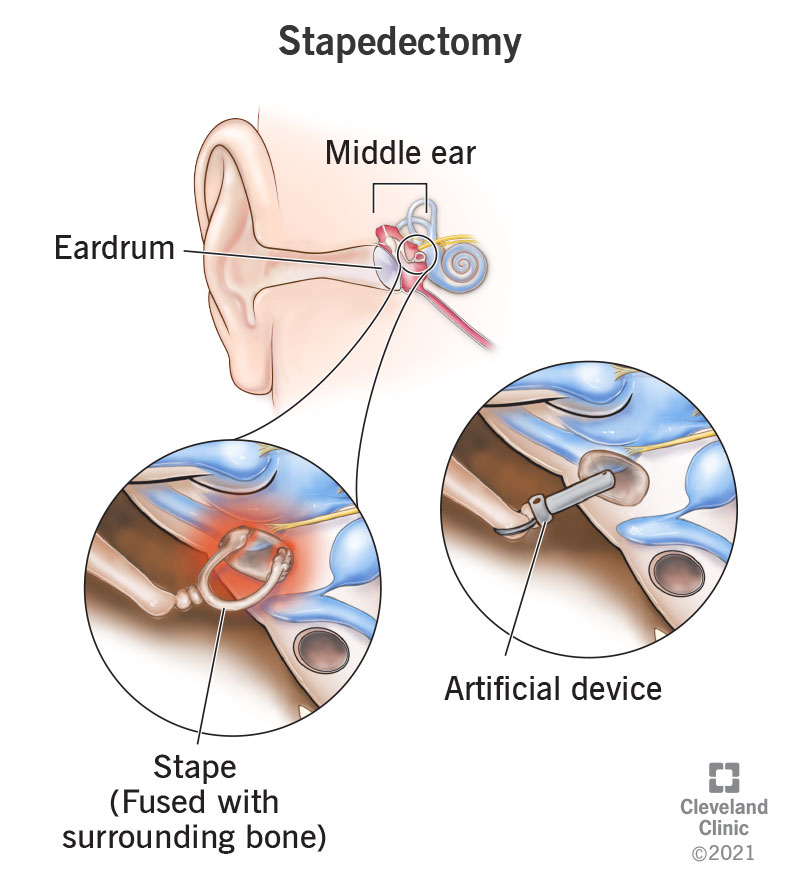A stapedectomy is surgery to treat hearing loss caused by otosclerosis. This condition affects your hearing by damaging your stape, a tiny U-shaped bone in your middle ear. Your stape helps you hear by sending sound waves from your middle ear to your inner ear. In a stapedectomy, healthcare providers replace your damaged stape with an artificial device.
Advertisement
Cleveland Clinic is a non-profit academic medical center. Advertising on our site helps support our mission. We do not endorse non-Cleveland Clinic products or services. Policy

Healthcare providers perform stapedectomy (stay-puh-dek-tuh-mee) surgery to restore your hearing. Stapedectomies repair middle ear damage caused by otosclerosis. This condition damages your stape, which is a tiny U-shaped bone in your middle ear that sends sound waves to your inner ear. Healthcare providers treat otosclerosis by replacing your stape with an artificial device.
Advertisement
Cleveland Clinic is a non-profit academic medical center. Advertising on our site helps support our mission. We do not endorse non-Cleveland Clinic products or services. Policy
You may need a stapedectomy if you have hearing loss caused by otosclerosis (oh-tuh-skli-roh-sis). This condition happens when your stape fuses with surrounding bone tissue, losing the flexibility it needs to transmit sound waves from your middle ear to your inner ear.
If you have otosclerosis, you may notice that over time you’re having trouble hearing people when they whisper. You may have trouble hearing low-pitched sounds. You may be able to hear better when there’s lots of background noise. Some people with otosclerosis start speaking more quietly because they think their voice is too loud. Other possible otosclerosis symptoms include:
Generally speaking, a major surgery is an operation when you need general anesthesia and breathing support because you can’t breathe on your own. Given those parameters, stapedectomy isn’t a major surgery.
Before you have a stapedectomy, your healthcare provider evaluates your hearing loss. Some steps your healthcare provider may take include:
Advertisement
Stapedectomies might be done as outpatient surgeries and last between 90 minutes to two hours.
If you’re having a stapedectomy, the steps your healthcare provider might take include:
You may have some mild pain or discomfort after your surgery. Ask your healthcare provider about over-the-counter pain medications you can take to ease your post-surgery symptoms.
You’ll be able to go home once you’ve recovered from anesthesia. You’ll need to rest for the first few days after your surgery. Most peoples’ ears heal after about six weeks. Here are some other things to expect after your stapedectomy:
Like any surgical procedure, a stapedectomy carries the risk of complications. While the procedure helps about 80% to 90% of people with otosclerosis, it may not be successful in some cases. In rare instances, your hearing may even be worse after surgery. Some other potential complications include:
The most common failure symptoms for stapedectomy are hearing that doesn’t improve after surgery or additional loss of hearing.
Most people who have a stapedectomy can return to normal routines in about one week. People whose jobs involve strenuous activity or heavy lifting may need to take additional time off.
Your healthcare provider may schedule a follow-up appointment one week after your surgery to check for vertigo or signs of infection. They may schedule another follow-up appointment four to six weeks after surgery to do hearing tests.
Advertisement
You should contact your healthcare provider if you have the following symptoms:
Stapedectomies treat otosclerosis, a condition that damages your middle ear. You may not realize you have otosclerosis until you notice you can’t hear people when they whisper or speak softly. Stapedectomies are an effective way of treating otosclerosis and restoring your hearing. If you’ve been diagnosed with otosclerosis, ask your healthcare provider if a stapedectomy may be the solution to your hearing problem.
Advertisement
Hearing is an important part of your everyday life. Hearing loss can impact your life in so many ways. Cleveland Clinic experts can help you hear clearly again.

Last reviewed on 02/04/2022.
Learn more about the Health Library and our editorial process.